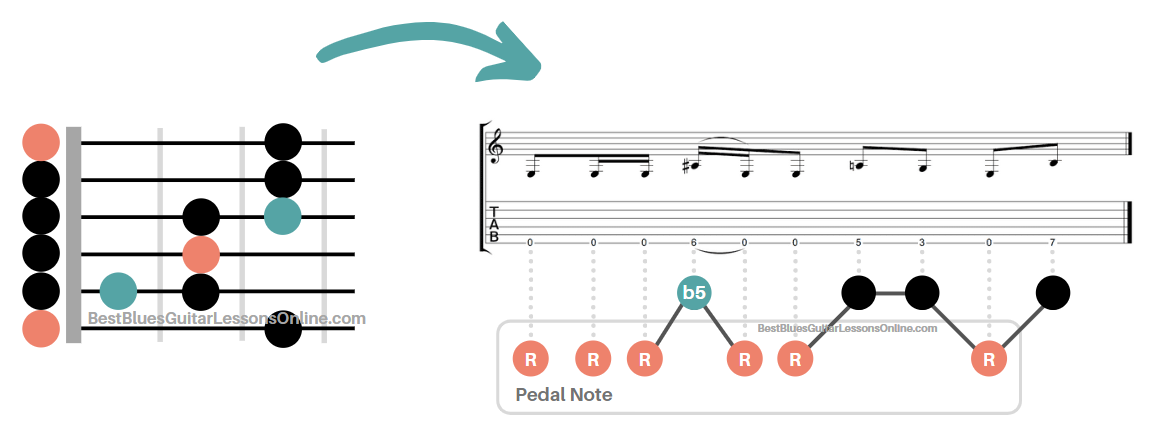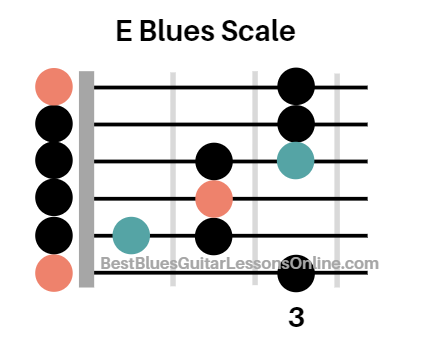How To Create Evil Sounding Rock & Metal Riffs Using The Blues Scale
By Antony Reynaert
One of the absolute biggest rewards when learning guitar is when it 'all comes together'. I remember when I started to realize that I could turn any scale into a great sounding guitar riff.

This was a big moment, because all the pieces I learned over the years suddenly made sense in a bigger picture.
If you want to create unique sounding riffs, all you have to do is to 'put the pieces of the puzzle together'. In order to do this, we need to cover some vital information that will not only make you a better guitarist, but will give you a thousand foot view of how scales and riffs work together.
How To Visualize The Blues Scale To Create Endless Riffs
As you could read from the title of this article we’re going to be using the blues scale to create cool sounding metal & rock riffs. So let’s just start from the absolute beginning. If I would ask you to visualize the blues scale on a piece of paper, I guess your drawing would probably look something like this:

This is absolutely perfect, but there is a huge disadvantage that comes from visualizing and memorizing the fretboard in this vertical manner. Too many people are caught up in memorizing the guitar fretboard in 'boxes' and stay trapped inside them.
How you visualize and memorize the fretboard is an extremely important component when we want to create riffs with the blues scale. Therefore, it’s crucial that we step away from the limitations of the boxes and look at the blues scale in a horizontal manner:

The great thing about learning your scales on one string is that this idea is easily applicable to writing your own music. Just play the notes from the blues scale one after the other on the low E string with a little bit of overdrive. You’ll notice that there are already very cool sounding rock/metal vibes coming out of your amp when doing this!
Once you start being creative with the duration of the notes and the order in which you play them, your riffs will come in no time.
How To Give Your Rock/Metal Riffs The Tension They Need
If you truly want to master your fretboard you need to start thinking in note functions and intervals. If you have never heard of intervals before, take a look at my Ultimate Guide In Understanding Intervals to gain all vital knowledge on these musical building blocks.
When looking at the blues scale, you can find the following interval formula: 1-b3-4-b5-5-b7
Knowing this is very important as each intervals brings its own flavour to the table. The reason why this blues scale is so often used is because of the existence of the b5 within the scale. This interval is one of the most used and indispensable intervals in music. Most of the music we listen to could not exist without it.
But the reality is that this b5 interval, also known as ‘the devils interval’, ‘tritone’, ‘blue note’ or 'diabolus in musica', is also one of the most malignant intervals ever. So the note on the sixth fret, is perfect to highlight in our metal/rock riffs.
Try playing this note right after playing the low E note (which is the root note). It creates a very dark and tense edge to your riffs.

In the video that accompanies this article I give multiple sound examples, so make sure to watch the video when reading along.
This Technique Will Give Your Riffs The Required Speed
When you want to write your own music it is important to go with a guitar teacher that doesn't tell you things like "just be creative". Knowing how to be creative is not as easy as it sounds so it is important to gather the right tools that you can use in order to spark your creativity. For this reason I will give you a much used, but often overlooked concept that will open a lot of doors to be creative with riffs.
You can basically hammer-on to any note of the blues scale and pull-off to the open string again. This guitar technique using ‘pedal notes’ in the form of open strings is the method to use in order to create a fast and driving feel to your guitar riffs. Because of that momentum it is a perfect fit for creating high intensity metal/rock riffs.

I demonstrate the pedal point technique in the video above so you’ll have a clear understanding on how this sounds.
The Final Step In Mastering Blues Scale Based Guitar Riffs
The last step in your road to becoming a master of using the blues scale to write metal/rock riffs is a very simple but crucially important step. Since we’ve only used single notes to create riffs, the riffs themselves might lack body and power. That’s why harmonizing the notes of the blues scale with powerchords can’t be overlooked.


As you can see from this article, you can create a lot of cool sounds that you probably didn’t really expect to be possible while using the blues scale. It is up to you now to put all the tools found in this article into practice and create some cool sounding guitar riffs.
 In addition to this, you also might want to dig deeper and add blues licks to your riffs.
In addition to this, you also might want to dig deeper and add blues licks to your riffs.
You see me doing this in the introduction of the video above.
I’ve created a Free Guide on playing fast blues licks on guitar, where you will see the licks written out in tablature and get advice on how to properly practice these licks.
Learn About The Guitar Soloing Lesson That Will Get Your Blues Lead Guitar Playing To The Next Level
